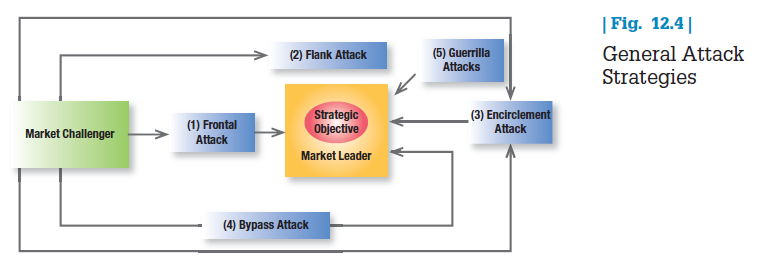Many market challengers have gained ground or even overtaken the leader. Toyota today produces more cars than General Motors, Lowe’s is putting pressure on Home Depot, and AMD has found some success chipping away at Intel’s market share. Challengers set high aspirations, while market leaders can fall prey to running business as usual. Challengers can also tap into public perceptions that they are the underdog.38 Now let’s examine the competitive attack strategies available to them.39
DEFINING THE STRATEGIC OBJECTIVE AND OPPONENT(S) its strategic objective, which is usually to increase market share. It then must decide whom to attack:
- It can attack the market leader. This is a high-risk but potentially high-payoff strategy and makes good sense if the leader is not serving the market well. Xerox wrested the copy market from 3M by developing a better copying process. Later, Canon grabbed a large chunk of Xerox’s market by introducing desk copiers. This strategy often has the added benefit of distancing the firm from other challengers.
- It can attack firms its own size that are not doing the job and are underfinanced. These firms have aging products, are charging excessive prices, or are not satisfying customers in other ways.
- It can attack small local and regional firms. Several major banks grew to their present size by gobbling up smaller regional banks, or “guppies.”
- It can attack the status quo. A challenger might not attack a specific firm as much as an industry as a whole or a pervasive way of thinking that doesn’t adequately address customer needs. Firms like Jet Blue, Ally Bank, and Netflix have succeeded by contrasting their services with those of competitors.40
CHOOSING A GENERAL ATTACK STRATEGY Given clear opponents and objectives, what attack options are available? As Figure 12.4 shows, we can distinguish five: frontal, flank, encirclement, bypass, and guerilla attacks.
- Frontal attack. In a pure frontal attack, the attacker matches its opponent’s product, advertising, price, and distribution. The principle of force says the side with the greater resources will win. A modified frontal attack, such as cutting price, can work if the market leader doesn’t retaliate and if the competitor convinces the market its product is equal to the leader’s. Helene Curtis is a master at convincing the market that its hair-care brands—such as Suave and Finesse—are equal in quality but a better value than higher-priced brands.
- Flank attack. A flanking strategy is another name for identifying shifts that cause gaps to develop in the market, then rushing to fill the gaps. Flanking is particularly attractive to a challenger with fewer resources and can be more likely to succeed than frontal attacks. Top communications companies such as Verizon, AT&T, and T-Mobile found themselves losing sales in the specialized but fast-growing prepaid smart-phone market when smaller carriers such as Boost Mobile, Virgin Mobile, and MetroPCS offered lower prices and greater selection.41 Another flanking strategy is to serve uncovered market needs. Ariat’s cowboy boots have challenged long-time market leaders Justin Boots and Tony Lama by making boots that are every bit as ranch-ready but ergonomically designed to feel as comfortable as a running shoe—a totally new benefit in the category.42 With a geographic attack, the challenger spots areas where the opponent is underperforming.
- Encirclement attack. Encirclement attempts to capture a wide slice of territory by launching a grand offensive on several fronts. It makes sense when the challenger commands superior resources. Back when it was pitched in a heated battle with much bigger rival Microsoft, Sun Microsystems licensed its Java software to hundreds of companies and thousands of software developers for all sorts of consumer devices. As consumer electronics began to go digital, Java started appearing in a wide range of gadgets.
- Bypass attack. Bypassing the enemy altogether to attack easier markets instead offers three lines of approach: diversifying into unrelated products, diversifying into new geographical markets, and leapfrogging into new technologies. In the “cola wars,” Pepsi used a bypass strategy against Coke by (1) rolling out Aquafina bottled water nationally in 1997 before Coke launched its Dasani brand; (2) purchasing orange juice giant Tropicana in 1998, when it owned almost twice the market share of Coca-Cola’s Minute Maid; and (3) purchasing the Quaker Oats Company, owner of market leader Gatorade sports drink, for $14 billion in 2 0 00.43 Coca-Cola has responded in turn with its own acquisitions. In technological leapfrogging, the challenger patiently researches and develops the next technology, shifting the battleground to its own territory where it has an advantage. Google used technological leapfrogging to overtake Yahoo! and become the market leader in search.
- Guerrilla attack. Guerrilla attacks consist of small, intermittent attacks, conventional and unconventional, including selective price cuts, intense promotional blitzes, and occasional legal action, to harass the opponent and eventually secure permanent footholds. A guerrilla campaign can be expensive, though less so than a frontal, encirclement, or flank attack, but it typically must be backed by a stronger attack to beat the opponent.

CHOOSING A SPECIFIC ATTACK STRATEGY Any aspect of the marketing program can serve as the basis for attack, such as lower-priced or discounted products, new or improved products and services, a wider variety of offerings, and innovative distribution strategies. A challenger’s success depends on combining several, more specific strategies to improve its position over time. Once successful, a challenger brand must retain a challenger mentality even if it becomes a market leader, highlighting the way it does things differently.
Source: Kotler Philip T., Keller Kevin Lane (2015), Marketing Management, Pearson; 15th Edition.

I?¦m not certain the place you’re getting your information, but great topic. I needs to spend some time finding out much more or understanding more. Thanks for magnificent information I used to be in search of this information for my mission.